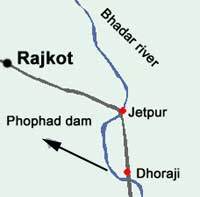The red triangle

l Solur, Tamil Nadu, May 1983. Investigations reveal that tanneries in nearby Ambur town have been releasing acidic waste into the river Palar, making the water toxic and unfit for drinking.
l Bhopal, December 2, 1984. Methyl isocyanate leaks out of containers in the Union Carbide factory. Many die, thousands affected .
l Delhi, December 4, 1985. Oleum gas leaks out of a factory owned by Sriram Foods and Fertilizers . Several people affected .
l Bichchri, 1988. Highly acidic substances seep out of the Silver Chemicals factory, contaminating wells and groundwater, affecting hundreds of poor farmers....
THESE are now well-known cases. But the story of Dhoraji town in Rajkot district, Gujarat, goes back further. The residents began agitating against pollution of the river Bhadar, their source of drinking water, in 1978. When public protests proved ineffective, they filed a petition. The case dragged on for 14 long years. On August 5, 1997, the citizens of Dhoraji won the case. The Gujarat High Court ordered the polluting units in Jetpur upstream of Dhoraji be shut down till effluent treatment plants were installed. A fine of Rs 1.25 crore was imposed on the industry. The government has recovered one-third of the amount, but the petitioners
Related Content
- S.Africa: Raw sewerage continues to flood major river
- Indonesia creates three marine protected areas within Coral Triangle
- The coral reef economy: the business case for investment in the protection, preservation and enhancement of coral reef health
- Sudan: One Death Confirmed As Water Shortage Now Life-Threatening to Miners in Sudan
- Women and corruption in the water sector: theories and experiences from Johannesburg and Bogotá
- Global Energy Architecture Performance Index Report 2017
